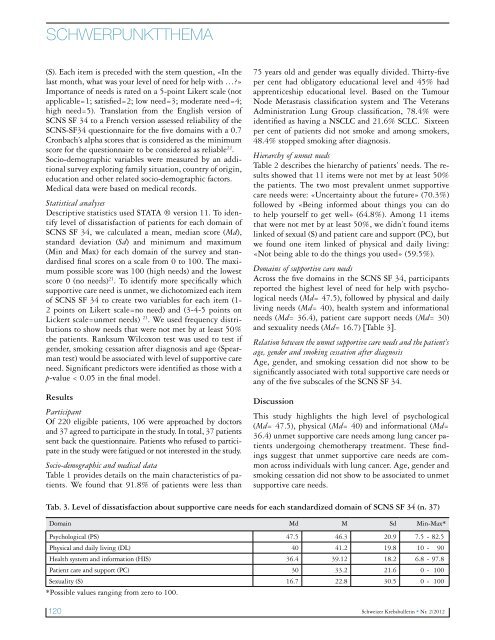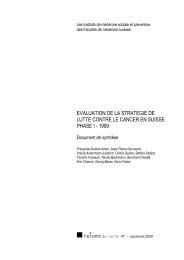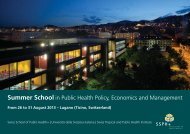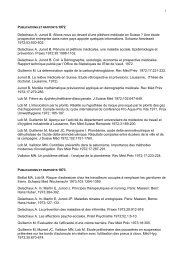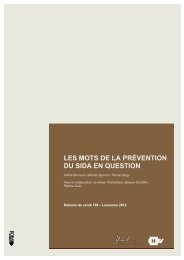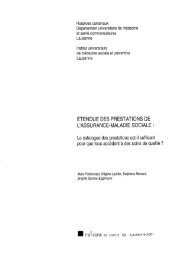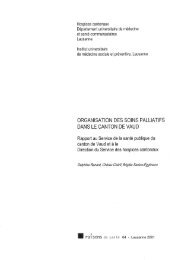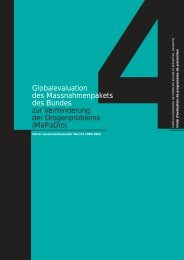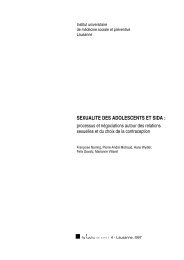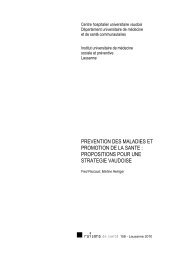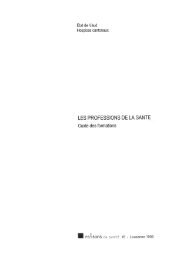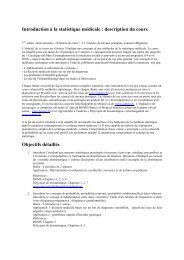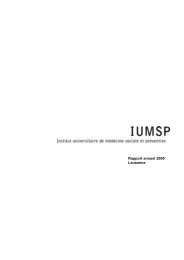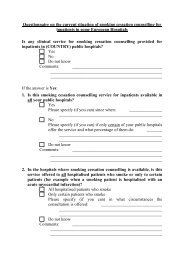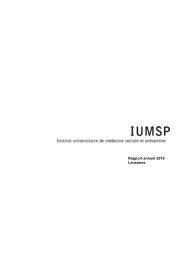Fortbildungen / Formations continues 2012 - IUMSP
Fortbildungen / Formations continues 2012 - IUMSP
Fortbildungen / Formations continues 2012 - IUMSP
Sie wollen auch ein ePaper? Erhöhen Sie die Reichweite Ihrer Titel.
YUMPU macht aus Druck-PDFs automatisch weboptimierte ePaper, die Google liebt.
SCHWERPUNKTTHEMA<br />
(S). Each item is preceded with the stem question, «In the<br />
last month, what was your level of need for help with …?»<br />
Importance of needs is rated on a 5-point Likert scale (not<br />
applicable=1; satis�ed=2; low need=3; moderate need=4;<br />
high need=5). Translation from the English version of<br />
SCNS SF 34 to a French version assessed reliability of the<br />
SCNS-SF34 questionnaire for the �ve domains with a 0.7<br />
Cronbach’s alpha scores that is considered as the minimum<br />
score for the questionnaire to be considered as reliable22 .<br />
Socio-demographic variables were measured by an additional<br />
survey exploring family situation, country of origin,<br />
education and other related socio-demographic factors.<br />
Medical data were based on medical records.<br />
Statistical analyses<br />
Descriptive statistics used STATA ® version 11. To identify<br />
level of dissatisfaction of patients for each domain of<br />
SCNS SF 34, we calculated a mean, median score (Md),<br />
standard deviation (Sd) and minimum and maximum<br />
(Min and Max) for each domain of the survey and standardised<br />
�nal scores on a scale from 0 to 100. The maximum<br />
possible score was 100 (high needs) and the lowest<br />
score 0 (no needs) 21 . To identify more speci�cally which<br />
supportive care need is unmet, we dichotomized each item<br />
of SCNS SF 34 to create two variables for each item (1-<br />
2 points on Likert scale=no need) and (3-4-5 points on<br />
Lickert scale=unmet needs) 21 . We used frequency distributions<br />
to show needs that were not met by at least 50%<br />
the patients. Ranksum Wilcoxon test was used to test if<br />
gender, smoking cessation after diagnosis and age (Spearman<br />
test) would be associated with level of supportive care<br />
need. Signi�cant predictors were identi�ed as those with a<br />
p-value < 0.05 in the �nal model.<br />
Results<br />
Participant<br />
Of 220 eligible patients, 106 were approached by doctors<br />
and 37 agreed to participate in the study. In total, 37 patients<br />
sent back the questionnaire. Patients who refused to participate<br />
in the study were fatigued or not interested in the study.<br />
Socio-demographic and medical data<br />
Table 1 provides details on the main characteristics of patients.<br />
We found that 91.8% of patients were less than<br />
75 years old and gender was equally divided. Thirty-�ve<br />
per cent had obligatory educational level and 45% had<br />
apprenticeship educational level. Based on the Tumour<br />
Node Metastasis classi�cation system and The Veterans<br />
Administration Lung Group classi�cation, 78.4% were<br />
identi�ed as having a NSCLC and 21.6% SCLC. Sixteen<br />
per cent of patients did not smoke and among smokers,<br />
48.4% stopped smoking after diagnosis.<br />
Hierarchy of unmet needs<br />
Table 2 describes the hierarchy of patients’ needs. The results<br />
showed that 11 items were not met by at least 50%<br />
the patients. The two most prevalent unmet supportive<br />
care needs were: «Uncertainty about the future» (70.3%)<br />
followed by «Being informed about things you can do<br />
to help yourself to get well» (64.8%). Among 11 items<br />
that were not met by at least 50%, we didn’t found items<br />
linked of sexual (S) and patient care and support (PC), but<br />
we found one item linked of physical and daily living:<br />
«Not being able to do the things you used» (59.5%).<br />
Domains of supportive care needs<br />
Across the �ve domains in the SCNS SF 34, participants<br />
reported the highest level of need for help with psychological<br />
needs (Md= 47.5), followed by physical and daily<br />
living needs (Md= 40), health system and informational<br />
needs (Md= 36.4), patient care support needs (Md= 30)<br />
and sexuality needs (Md= 16.7) [Table 3].<br />
Relation between the unmet supportive care needs and the patient’s<br />
age, gender and smoking cessation after diagnosis<br />
Age, gender, and smoking cessation did not show to be<br />
signi�cantly associated with total supportive care needs or<br />
any of the �ve subscales of the SCNS SF 34.<br />
Discussion<br />
This study highlights the high level of psychological<br />
(Md= 47.5), physical (Md= 40) and informational (Md=<br />
36.4) unmet supportive care needs among lung cancer patients<br />
undergoing chemotherapy treatment. These �ndings<br />
suggest that unmet supportive care needs are common<br />
across individuals with lung cancer. Age, gender and<br />
smoking cessation did not show to be associated to unmet<br />
supportive care needs.<br />
Tab. 3. Level of dissatisfaction about supportive care needs for each standardized domain of SCNS SF 34 (n. 37)<br />
Domain Md M Sd Min-Max*<br />
Psychological (PS) 47.5 46.3 20.9 7.5 - 82.5<br />
Physical and daily living (DL) 40 41.2 19.8 10 - 90<br />
Health system and information (HIS) 36.4 39.12 18.2 6.8 - 97.8<br />
Patient care and support (PC) 30 33.2 21.6 0 - 100<br />
Sexuality (S)<br />
*Possible values ranging from zero to 100.<br />
16.7 22.8 30.5 0 - 100<br />
120 Schweizer Krebsbulletin � Nr. 2/<strong>2012</strong>


